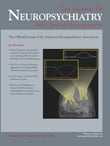Co-occurrence of Psychiatric Symptoms With Cerebellar Venous Malformation: A Case Report
To the Editor: The cerebellum has been regarded as primarily involved with motor coordination. However, the importance of the cerebellum in psychiatric disorders, cognition, and behavior is increasingly being recognized. 1 In a study of patients with cerebellar degeneration, 2 depression was present in 68% of participants. The cerebellar degeneration group had an overall rate of psychiatric disorders of 78%, which included personality change, anxiety, and psychotic disorders. 2 We present a case of depressive disorder with psychotic features and cerebellar venous malformation.
Case Report
Our patient was a 40-year-old man who presented to our outpatient clinic with rigidity, tremor, bradykinesia and bradymimia, insomnia, demoralization, loss of appetite, hopelessness, auditory hallucinations such as “someone will have him … gotten rid of from his work, to be divorced,” and persecutory delusions. The initial Extrapyramidal Rating Scale (EPRS) score was 40 points. He was hospitalized with a diagnosis of depressive disorder with psychotic features and neuroleptic-induced parkinsonism. Six weeks ago, he was diagnosed with schizophrenia and we administered zuclopenthixole depot, 200 mg/day for 2 weeks. He was also treated with 4 mg/day of risperidone. The patient had a history of hearing loss for approximately 20 years. We initiated olanzapine, 10 mg/day, biperiden, 6 mg/day, and lorazepam, 2 mg/day, and tapered risperidone within 3 days. We added venlafaxine, 75 mg/day, 2 weeks later after relief of extrapyramidal symptoms (EPRS score =14). In routine examination, the patient was unable to stand, and we detected ataxia after the improvement of extrapyramidal symptoms in the second week (EPRS score =0). There was a linear vascular lesion on the MRI, localized near the vermis within a 2 mm 2 area (concordant with the venous malformation image that had slow blood flow signals), which extended like caput medusae in the medial parenchyma of the left cerebellar hemisphere ( Figure 1 ).

Discussion
Soft neurological signs including subtle ataxia, coordination difficulties, dysdiadochokinesia, and intentional tremor were frequently reported in patients with schizophrenia. In addition, presence of positive symptoms (especially delusions) and negative symptoms including flattened affect, avolition, social isolation, and poverty in speech have been frequently found in people with cerebellar lesions. 3 In anatomic tracing studies, some pathways are suggested to link the cerebellum with autonomic, limbic, and associated regions of the cerebral cortex. This allows the cerebellum to relate to instinctive behaviors, mood, and executive functioning and reasoning. 4 The cerebellar cognitive affective syndrome described in some patients may add clinical evidence to conclusions made in animal anatomy studies and with functional imaging data for understanding the role of the cerebellum beyond motor control response. 5 Thus, the present case was considered in light of the abovementioned debates. Frequent persecutory delusions in patients with chronic hearing impairment which might lead to paranoid psychosis in later life are a well-known issue. Although there were persecutory delusions in our patient, these were congruent with mood. In addition, we recommend exploring the association between affective psychosis and cerebellar venous malformation. The neurosurgeons did not indicate operation and planned to follow up with the patient.
1. Ho B-C, Mola C, Andreasen NC: Cerebellar dysfunction in neuroleptic naive schizophrenia patients: clinical, cognitive, and neuroanatomic correlates of cerebellar neurologic signs. Biol Psychiatry 2004; 55:1146–1153Google Scholar
2. Leroi I, O'Hearn E, Marsh L, et al: Psychopathology in patients with degenerative cerebellar diseases: a comparison to Huntington’s disease. Am J Psychiatry 2002; 159:1306–1314Google Scholar
3. Baldaçaral L, Borgio JG, de Lacerda AL, et al: Cerebellum and psychiatric disorders. Rev Bras Psiquiatr 2008; 30:281–289Google Scholar
4. Schmahmann JD: Disorders of the cerebellum: ataxia, dysmetria of thought, and the cerebellar cognitive affective syndrome. J Neuropsychiatry Clin Neurosci 2004; 16:367–378Google Scholar
5. Schmahmann JD, Weilburg JB, Sherman JC: The neuropsychiatry of the cerebellum: insights from the clinic. Cerebellum 2007; 6:254–267Google Scholar



